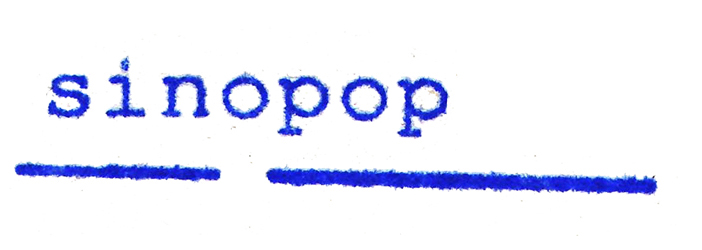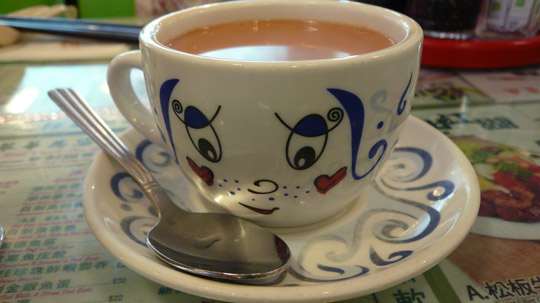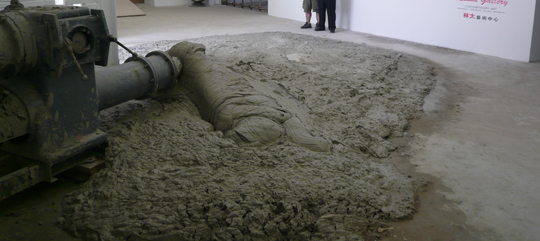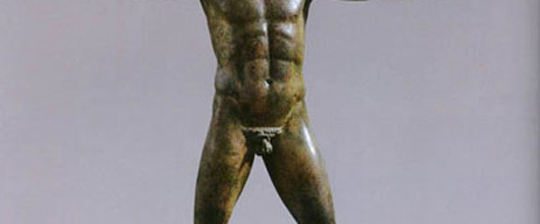张达的O形
In a hidden corner in 798, lies a surprise awaiting fans of minimalist fashion, playful irony and small, independent fashion labels …
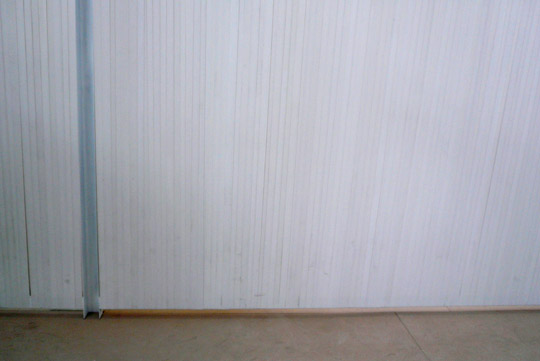
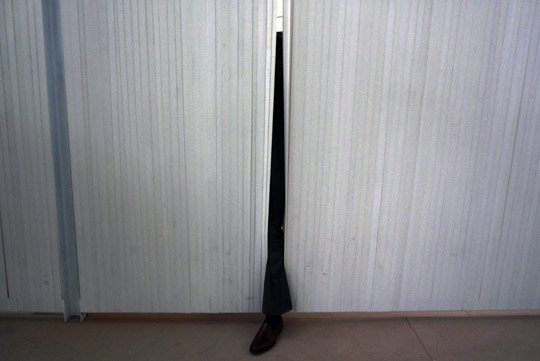
成都再生环保纸小学
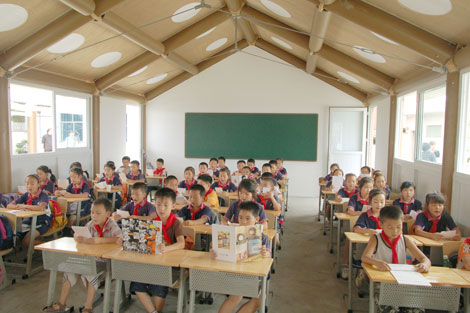
谁决定临时的避难所必须得寒碜?2008年九月在成都的郊区,日本建筑师坂茂的事务所跟中国建筑师合作绿色小学活动房项目竣工。 这所漂亮的小学使用了再生环保纸做支柱,宽敞而舒服,是孩子们应得的。在日本设计博客 PingMag 可看到更多的照片以及对项目经理的访谈记录。
PingMag 还有跟中国建筑师马岩松的访谈,看这连接
张培力 / 倪海峰:拨出制造业国家的特点
In Shenzhen’s OCT Contemporary Art Terminal , Zhang Peili installed his third solo of 2008, again featuring remains, Mute. In this “scene” (a “new form of art” that Zhang Peili has been developing, he contrasts the real and the perceived, the static and the dynamic, over the abandoned reckage of manufacturing sewing tables and two parallel video projections of people working in the exact same space.
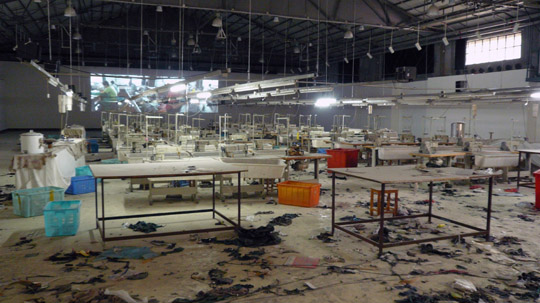
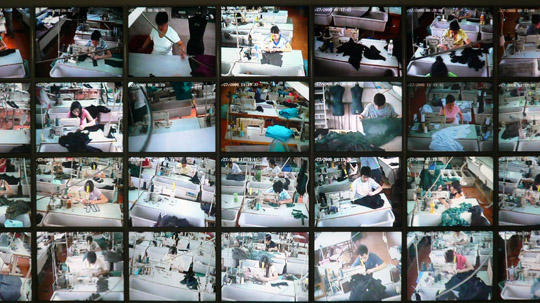
Concurrently, at Beijing’s JoyArt Space, Ni Haifeng (artist site) employs similar on-site tailors who shredded, then reconstruct more than 10 tons of reclaimed fabric in Para Production. The result is a wall sculpture that reaches to the ceiling; remains are scattered across the space. The show is curated by Pauline Yao, see more photos of the show and its installation at her site.
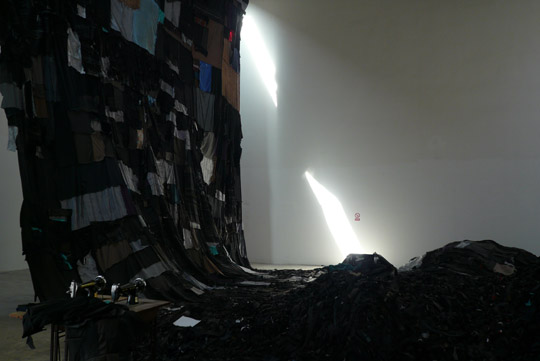
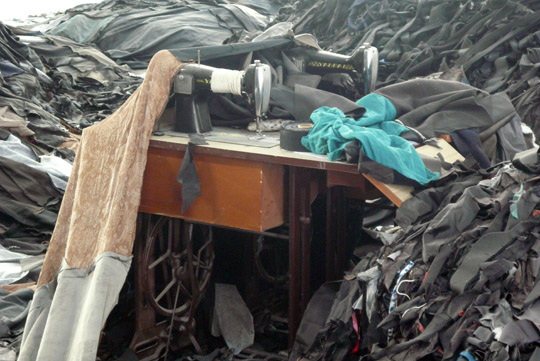
Although these two artists have different aims, the similarity of their means is outstanding. Both employ anonymous, live performers in the installation of, and integrally in the manufacture of their works. Both use the reconstructing, reorganizing and recontextualizing of materials, Ni Haifeng working with the fabric itself, and Zhang Peili with video clips that he garnered from a performance within the space. Both display their final product (fabric-sculpture, video montage) amidst the un-edited ruins of its production process.
For more “common threads” and variations on this theme, please reference Zheng Guogu’s Factory exhibition, January 2008 at Beijing’s Tang Contemporary.
More exhibition scenes below . . .
皮埃尔·于贝尔创作奖提名展
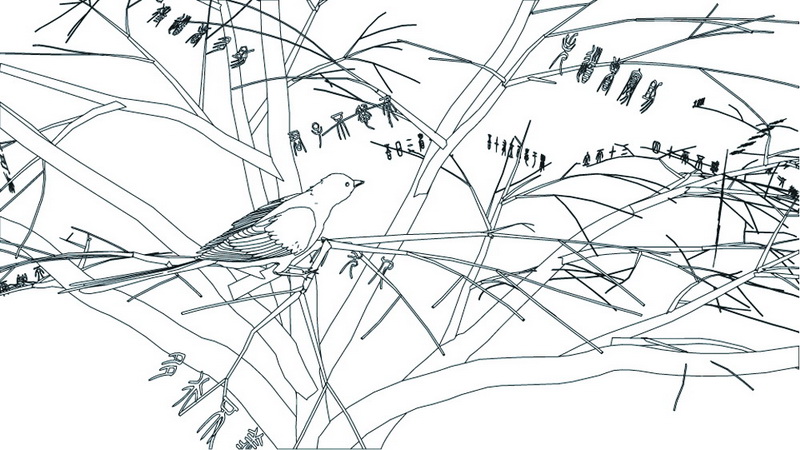
陈春
Chen Chun
《鸟之死》The Bird’s Death
动画 Animation
7 ′ 30 ″ 2008
Ten students from the New Media Art Department of the China Art Academy (Zhejiang) display their work in 798’s T-Space. These students were vying for the “Pierre Huber Creation Prize”scholarship, a prize furthering creativity in the fine arts that was established last year in 2007. The winner, Li Ming, took the prize with a video of a crude backhoe combing a young woman’s tangled hair. She sits in the rubble of a destroyed home.
The show is an interesting focus on some of China’s young talent, and it is nice to see perspectives from outside of Beijing. Still, I was surprised to see how many of these works were extensions of common tropes in Chinese art: photo series (featuring migrant laborers, people in their underwear) and the “24 video documenting absolute nothing while I sit in my dirty room for days at a time”. I have seen several variations on this theme on display in Beijing over the last 6 months alone.
I was particularly moved by Li Fuchun’s (a runner up) helium balloons lifting a board on which was scattered the creamated remains of a human. That work touched a nerve and tapped into a sense of the ethereal, almost reaching a state of expression that can’t quite be put into words, something that I consider a higher form of contemporary art. Unfortunately, it was stuck in a corner of the stairway by the time I encountered it. Wang Liang sat at his loom weaving a black and white pattern out of a random generated code of 1 and 0’s, which I also enjoyed, but the process and result seemed too similar to Lu Qing’s long hand-painted silk for me to feel comfortable.
Even though the majority of the works had a witty sense of academia hovering about them, all were wonderfully executed. Their installation also put many local galleries to shame. T Space has done a great job at working for furthering the definition of art. This student exhibition was also a great step for what is trying to be a “non-profit” space in Beijing. Congrats to to Mr. Huber, who has solidified his name as legend in Chinese contemporary arts. The next best thing to opening an enormous space named after you, is to commemorate yourself with a prize.
”微妙“ 在站台中国
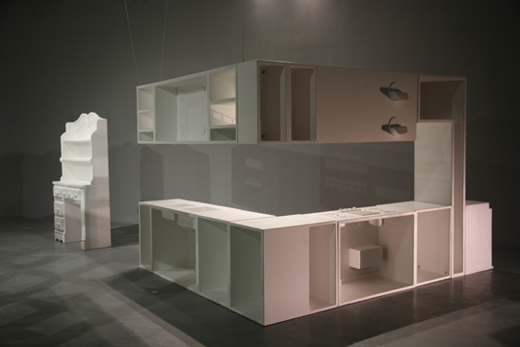
站台中国
朝阳区草场地村319-1艺术东区A区内
2008.08.30-2008.10.12中国文化浸染于含蓄微妙的暗示中,有时候这种暗示过于微妙,以至于很容易就被忽略。“微妙”展中,策展人凯伦·史密斯 (Karen Smith)精心选择了九位中国艺术家的作品--他们来自不同的年代,采用的是不同的媒介,思考过程各具不同的创意性——由此展现了历史性的精致提炼。
王卫根据场地,创作了定点装置,对于展览空间进行了变形。他将房产工事模型中使用的一组小型的家具扩大。等身大小的衣橱和厨房柜子对于这个空间,产生了很奇特的效果,创造了一种双重性的身份。这些令人惊异的白木雕,因其环氧树脂合成的边缘,而更增添了其人工性,从而令它们表面看起来,就好像是从塑料模子中打造出来的一样。艺术伴侣胡晓媛和仇晓飞,在相邻的房间里展出了各自的作品;每位艺术家运用的是现有物品的组合以及常规的媒介方式,激起的是人们的怀旧之情。在《不动产》(2008),仇晓飞将一些从跳蚤市场弄来的物品,安置摆放,形成一间完成的居所,走廊的入口侧,堆积的是废弃的电器,炊具,以及用上漆的木头再造的逼真的扩音器。而胡的《夏至》(2008),则更具有象征主义意味,同时也更讲究组织构造性:一张破败的课桌上面堆满了蝉的蜕皮;成形于粗糙的造型艺术的日常用品摆放在上面小小的木头架上,一卷从打开的抽屉里垂下来的白纸,一直垂到了地板上。课桌和教学用品暗示着教育体系,蝉意味着在这种严酷的、适者生存的教育体制下,一年一年的蜕变。在另一间屋子里,以画萧瑟风景、戴防毒面具的不详人物而著名的年轻画家贾蔼力,呈现了一幅从火车窗口拍摄的窗外录像。通过使用炭精笔,他绘制的逼真的缝隙,轻薄的长袍,空白的画布,覆盖了将近16英尺高的墙。一束超脱尘俗的光在并不存在的拥挤的墙上,投下了影子,灰暗的房间中是两个空间性的物体,一个标志性的魔鬼般的防毒面罩从中央,就那么凝视着观者。
— 文/ Lee Ambrozy, 译/ 王丹华
更多的展览评论在 artforum.com.cn
找自己:已找到了
Some of us look forever, others never seek––perhaps they’re already found “ME.” New September 2008 publication is a compilation of short texts and artwork images documenting China’s new generation of “Post 70s” artists. Included within are 30 artists, each artist includes a short introduction, three full pages of color images, and up-to-date artist resumes, there is even a photograph of each artist, in the old school, i.d. photo style.
These artists included are among the most outstanding of their generation, they represent Mainland China’s up-and-coming talent in the visual arts. Although often called the “Post 70s” generation, the artists here are mostly born after 1975. The book is a compliment to the exhibition of the same name, curated by Fang Fang (art director of Star Gallery and 2006 exhibition “Naughty Kids”), but is meant to stand on its own, and become a resource tool for those interested in this younger generation of artists, a browsing book.
If you’re like everyone else I know, you’re thinking: What does the name mean?
After spending a summer on this book, researching these artists, writing texts, translating and pondering the very same question I can only say: It means what ever you want it to. Whatever looking for you might entail. May you find it within!
Artists: Ouyang Chun / Li Jikai / Wei Jia / Qin Qi / Huang Yuxing / Xiong Yu / Wen Ling / Wang Guangle / Liu Ding / Li Hui / Qiu Jiongjiong / Song Kun / Wang Yaqiang / Liang Yuanwei / Cao Fei / Wang Yifan / Li Chaoxiong / Chen Ke / Xu Maomao / Jia Aili / Gao Yu / Li Qing / Qiu Xin / Wen Chuan / Yan Cong / Ha Migua / Chen Fei / Jin Nv / unmask
Book design: Liu Zhizhi MEWE
Authors: Lee Ambrozy / Jing Xiaomeng / Gong Jian / Huang Shan / Helen Li / Pauline J Yao / Chang Chang
“悬在空中、浮于表面、不能靠近”
“悬在空中、浮于表面、不能靠近”是林达画廊的首次展览 , 隋建国最新的创造 《无题》流淌在门口的地面上,观众的确不要靠近,因为《无题》还没有干。本展览由朱其策划也包括不少顶级艺术家,像展望、汪建伟、王鲁炎等,也有我很反感的艺术家张鹏和苍鑫。
这次真正把我给骗了,它半途而废的结果实在太像林达画廊赶着展出,装修没完成的样子了。我不得不想,他的作品是否有讽刺的用意,也许只是隋老师做展览做累了而已。祝贺您隋老师!我服了。
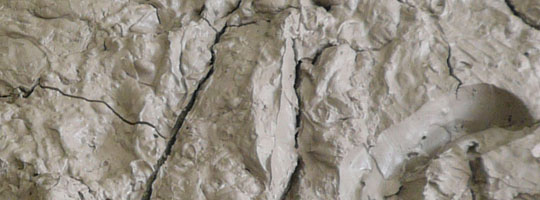
世艺网: 特殊奥运报道
These past two weeks, every communication included something along the lines of “How are the Olympics,” or “hope you’re surviving the Olympics”. The answer: smothering, and just barely.
Now that they have concluded, I feel that ominous burden slowly melting from my psyche, and I realize that I was truly not “coping well” with the games. I was instead lying low, playing dead, unable to watch or even comment on this historic event. Instead, I escaped the steamy red and yellow fervor emanating from the Bird’s Nest stadium by flying off to Yunnan province, a necessary act of “self-protection” (a Chinese pun on “avoiding the Olympics” and “contraception”) but the fervor pursued.
The NYT headlines mocked me in my inbox, conflicting and paradoxical news “angles” from American and Chinese news sources accumulated, champions wept or chomped on their lead-tinged gold medals over the endless highlights montages that were repeating on televisions across China, on every CCTV station, in the airport, in the bus station, waiting for elevators…
From 29, 49, to 51 gold medals––this news tracked me down even at 2000+ meters above sea level. Perhaps it wasn’t altitude sickness at all that left me vomiting in the bathroom. The record-breaking conclusion of the games was a victory for the Chinese spirit, for which I extend my true congratulations.
After returning to Beijing, and while browsing one of my favorite stress-relieving Chinglish sites, the Century Online China Art Networks, my “unprotected” eyes were despoiled by an unusual, but seemingly Olympics related headline: “Why does so much ancient Greek art feature males with small genitalia.” An English article posted on August 22, 2008 and signed “CL2000.com.” Here, among Beijing exhibition reviews, a feature on Buddhist sand mandalas, and a piece on the Jewish Museum, was this seemingly out of place reportage on the heft and quality of ancient Greek genitals as evidenced in statuary. Read the rest of this entry »
看热闹的随笔
以下的文章发表再英国杂志 Art Review 电子版
by Lee Ambrozy (post from ArtReview.com)
On a day of orgasmic auspiciousness in China, 08/08/08, crowds piled into bars, parks, official ‘fanzones’ outside the Olympic stadium and the old Workers’ stadium, and along Beijing’s ancient north-south axis to watch the opening ceremony collectively on big screens and get the best view of Cai Guo-Qiang’s city-wide fireworks display (they would be the only ones to see the real real fireworks, rather than the computer graphics that appeared on TV). But far removed from these displays of patriotism, and perhaps soured by an already suffocating ‘Olympic spirit’, most of us in Beijing’s artworld chose to scrutinize the ceremonies from our couches.
Still, with cultural giants Zhang Yimou (celebrated director of House of Flying Daggers (2004)) and ace fireworker Cai Guo-Qiang, fresh from his huge exhibition at the New York Guggenheim, behind this production, our expectations were almost as high as the $300 million budget. Responses from the intellectual and creative communities in China were quick and overwhelmingly negative. On his blog, Ai Weiwei, design consultant on the Bird’s Nest and now an outspoken critic of the government in the run up to the games, called it ‘an encyclopedic display of a spiritual consciousness fallen into enemy hands’.
The Chinese know how to exploit manpower, and communism loves its gala performances. Zhang Yimou seemed to be borrowing the techniques of North Korea’s Arirang Mass Games (recently photographed by Andreas Gursky): using people-as-pixels to form staggering, intimidatingly huge collective images in which the individual is subsumed entirely, yet still crucial to the perfection of the big picture.
continue reading here
